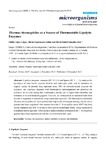Thermus thermophilus as a Source of Thermostable Lipolytic Enzymes

Use this link to cite
http://hdl.handle.net/2183/19538Collections
- Investigación (FCIE) [1236]
Metadata
Show full item recordTitle
Thermus thermophilus as a Source of Thermostable Lipolytic EnzymesDate
2015Citation
López-López, O.; Cerdán, M.-E.; González-Siso, M.-I. Thermus thermophilus as a Source of Thermostable Lipolytic Enzymes. Microorganisms 2015, 3, 792-808.
Abstract
Lipolytic enzymes, esterases (EC 3.1.1.1) and lipases (EC 3.1.1.3), catalyze the hydrolysis of ester bonds between alcohols and carboxylic acids, and its formation in organic media. At present, they represent about 20% of commercialized enzymes for industrial use. Lipolytic enzymes from thermophilic microorganisms are preferred for industrial use to their mesophilic counterparts, mainly due to higher thermostability and resistance to several denaturing agents. However, the production at an industrial scale from the native organisms is technically complicated and expensive. The thermophilic bacterium Thermus thermophilus (T. thermophilus) has high levels of lipolytic activity, and its whole genome has been sequenced. One esterase from the T. thermophilus strain HB27 has been widely characterized, both in its native form and in recombinant forms, being expressed in mesophilic microorganisms. Other putative lipases/esterases annotated in the T. thermophilus genome have been explored and will also be reviewed in this paper.
Keywords
Thermus thermophilus
Lipase
Esterase
Lipolytic
Thermophilic
Lipase
Esterase
Lipolytic
Thermophilic
Editor version
Rights
Reconocimiento 3.0
ISSN
2076-2607






